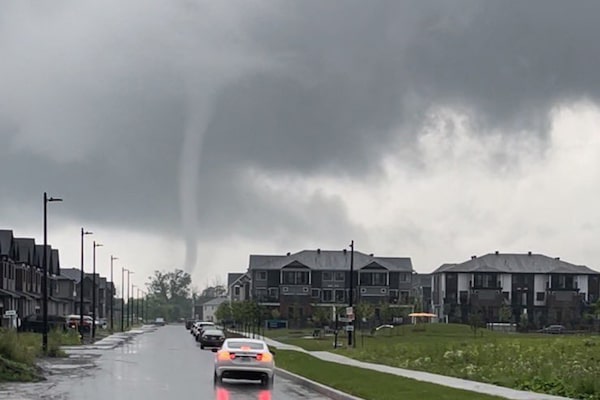
A funnel cloud in Barrhaven, Ont., just outside of Ottawa on July 13.HO/The Canadian Press
More than 100 homes were damaged and one person was injured Thursday afternoon when a tornado ripped through a suburban neighbourhood in Ottawa.
Environment Canada confirmed at least one tornado touched down in Barrhaven, a suburb in Ottawa located about 20 kilometres from the city’s centre. Tornado warnings were issued for Ottawa North at 12:49 p.m. on Thursday and were extended east through the city to Prescott and Russell counties at 1:10 p.m., with the tornado touching down somewhere during this time.
Multiple videos on Twitter show a funnel cloud forming then touching down in the Half Moon Bay area of Barrhaven, carrying debris with it. Other photos on the social media site show houses without siding or exposed insulation, broken windows, fallen power lines and trees fallen on cars.
Another tornado warning was issued at 2:46 p.m. but no damage has been reported from this warning.
Ottawa fire chief Kim Ayotte told a news conference that 125 houses were damaged and one person suffered minor injuries. The tornado also knocked downed trees and hydro poles.
Mr. Ayotte said five families had already arrived at the Minto Recreation Complex in Barrhaven which has been established as a family reunification centre with supports from the Salvation Army and Red Cross.
Deputy chief of police Steve Bell said crews were still assessing the damage, including looking for gas leaks and other safety risks.
“This incident still has a large footprint and officers and all city and service partners are working together are road closures currently in effect due to fallen trees, electrical wires, and other debris,” said Deputy Chief Bell.
Ottawa Mayor Mark Sutcliffe sent his sympathies to families affected by the tornado and said Ontario Premier Doug Ford reached out a few minutes after the news of the tornado broke to offer the province’s support to the city.
One of the affected homes is Laurie Gillespie’s mother’s house, which suffered significant damage. Ms. Gillespie said her mother and her sister were at home when her sister noticed a storm coming in and stepped outside to pull in a chair so it wouldn’t blow away.
“Just as she came back inside, the back window blew in and the screen came flying across the room and landed at my mother’s feet,” Ms. Gillespie told The Canadian Press.
“The curtains on the bathroom window were sucked right out and they ended up on the roof.”
She said there is damage for about a two- to three-block radius around her mother’s home. Some roofs were ripped apart, and foam blocks used as insulation in the attics exploded.
Debris in front of damaged homes following the Barrhaven tornado.Sean Kilpatrick/The Canadian Press
Monica Vaswani, a warning preparedness meteorologist at Environment and Climate Change Canada, said it is still too early to rate the strength of the tornado on the Enhanced Fujita, or EF, scale, which ranks tornado damage from EF0 to EF5, with higher numbers indicating faster wind gusts.
However, the Northern Tornados Project through University of Western Ontario, who partners with Environment and Climate Change Canada, had already arrived on site to access the damage within a few hours of the tornado.
“We have seen reports of roofs blown off in Barrhaven. I’ve seen some pictures of what looks like foam insulation strewn about, but that will definitely be something lighter for a tornado to pick up,” Ms. Vaswani said.
This is the second tornado in the Ottawa region in the last five years. In 2018, an EF3 tornado hit the Dunrobin region in the Ottawa Valley before moving into Gatineau, Que., causing extensive damage. Ms. Vaswani said an EF3 tornado is far more rare than an EF0 or EF1, which are more common in the region.
Although tornadoes occur in urban areas more infrequently, Ms. Vaswani warns not to assume that more densely populated areas are less likely to be affected by tornadoes.
“I feel like there’s maybe this notion that they don’t necessarily happen in populated areas or big cities, but that’s actually completely false,” she said. “There are cities that do end up seeing these more frequently than others. Barrie’s one of them, communities in the Ottawa Valley are others and that’s just because of their geographic situation.”
Environment Canada has confirmed a separate tornado touched down Thursday in Mirabel, Que., north of Montreal.
The weather agency says the tornado was observed in a field around the town’s airport, though no injuries or damage were reported.
With files from The Canadian Press
 Joy SpearChief-Morris
Joy SpearChief-Morris